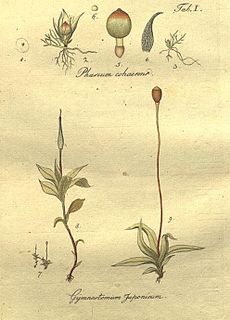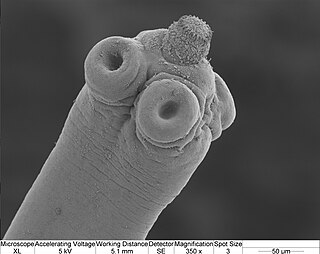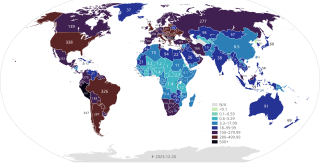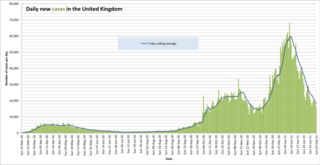2021 (MMXXI) is the current year, and is a common year starting on Friday of the Gregorian calendar, the 2021st year of the Common Era (CE) and Anno Domini (AD) designations, the 21st year of the 3rd millennium, the 21st year of the 21st century, and the 2nd year of the 2020s decade.
The slender argentine, Microstoma microstoma, is a species of pencil smelt, found around the world in tropical and subtropical areas. This species grows to a length of 21 centimetres (8.3 in) TL. Its main food includes other fish, and its feces.

Ham Hill is an area of chalk downland in Wiltshire, England, on the steep banks running alongside the road from the village of Ham to Buttermere, close to the Berkshire border. A biological Site of Special Scientific Interest, notified in 1971, covers 1.5 hectares of the site; this designation is due to the site's species-rich plant and insect communities, which include some rare species. Notable among these is the musk orchid, which has been confirmed at only one other site in Wiltshire.

Gymnostomum is a genus of bryophyte in family Pottiaceae. It was first described by Christian Gottfried Daniel Nees von Esenbeck and Christian Friedrich Hornschuch

Christian Friedrich Hornschuch was a German botanist born in Rodach, Bavaria.

Macropinna microstoma is the only species of fish in the genus Macropinna, belonging to the Opisthoproctidae, the barreleye family. It is recognized for a highly unusual transparent, fluid-filled dome on its head, through which the lenses of its eyes can be seen. The eyes have a barrel shape and can be rotated to point either forward or straight up, looking through the fish's transparent dome. M. microstoma has a tiny mouth and most of its body is covered with large scales. The fish normally hangs nearly motionless in the water, at a depth of about 600 metres (2,000 ft) to 800 metres (2,600 ft), using its large fins for stability and with its eyes directed upward. In the low light conditions it is assumed the fish detects prey by its silhouette. MBARI researchers Bruce Robison and Kim Reisenbichler observed that when prey such as small fish and jellyfish are spotted, the eyes rotate like binoculars, facing forward as it turns its body from a horizontal to a vertical position to feed. Robison speculates that M. microstoma steals food from siphonophores.

Hymenolepis microstoma, also known as the rodent tapeworm, is an intestinal dwelling parasite. Adult worms live in the bile duct and small intestines of mice and rats, and larvae metamorphose in the haemocoel of beetles. It belongs to the genus Hymenolepis; tapeworms that cause hymenolepiasis. H. microstoma is prevalent in rodents worldwide, but rarely infects humans.

Cryphaea is a genus of mosses, (Bryophyta), containing at least 26 accepted species.

Mniaceae is a family of mosses.

This article provides a general overview and documents the status of locations affected by the severe acute respiratory syndrome coronavirus 2 (SARS-CoV-2), the virus which causes coronavirus disease 2019 (COVID-19) and is responsible for the COVID-19 pandemic. The first human cases of COVID-19 were identified in Wuhan, the capital of the province of Hubei in China in December 2019. The most recent country or territory to report its first confirmed case was the Federated States of Micronesia on 8 January 2021.

The following is a timeline of the COVID-19 pandemic in the United Kingdom during 2021. There are significant differences in the legislation and the reporting between the countries of the UK: England, Scotland, Northern Ireland, and Wales. The numbers of cases and deaths are reported on a government Web site updated daily during the pandemic. The UK-wide COVID Symptom Study based on surveys of four million participants, endorsed by authorities in Scotland and Wales, run by health science company ZOE, and analysed by King's College London researchers, publishes daily estimates of the number of new and total current COVID-19 infections in UK regions, without restriction to only laboratory-confirmed cases.
Weissia is a genus of mosses, belonging to the family Pottiaceae.
Gymnostomum calcareum is a species of moss belonging to the family Pottiaceae.
Weissia squarrosa is a species of moss belonging to the family Pottiaceae.
Ptychostomum is a genus of mosses belonging to the family Bryaceae.
Macromitrium is a genus of mosses belonging to the family Orthotrichaceae.








